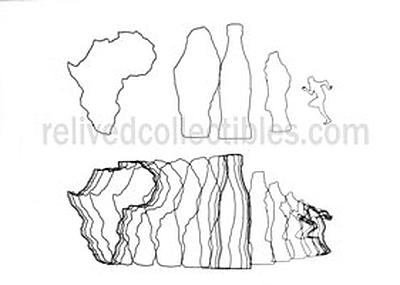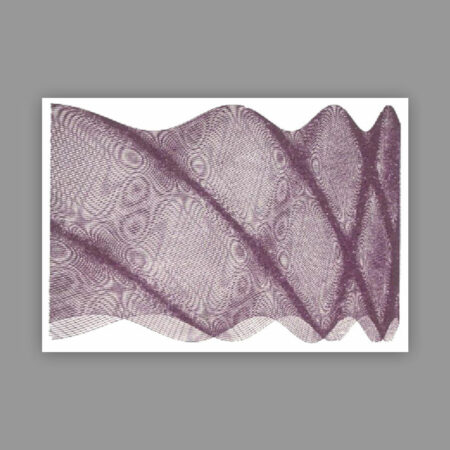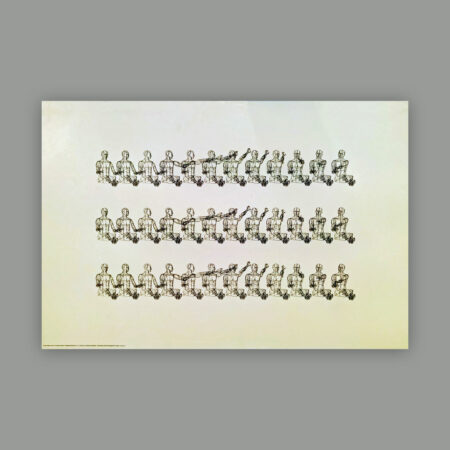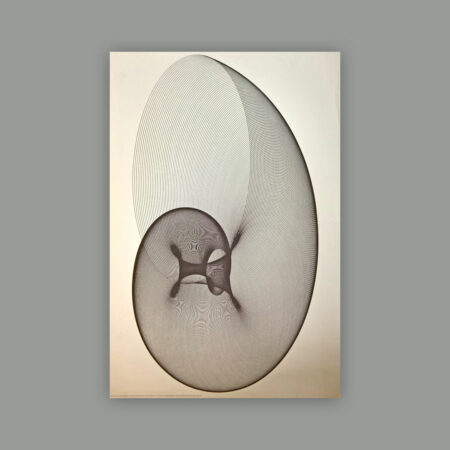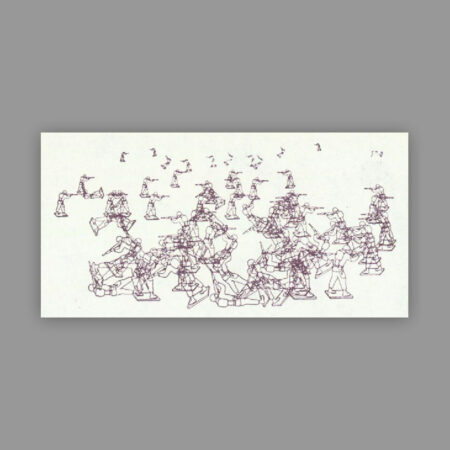Creative Computers
Cybernetic Serendipity – the computer and the arts
Running Cola is Africa 1967/68
A computer graphic, No. 3 in the Metamorphoses Series by the Computer Technique Group from Japan.
Idea by Masao Komura (product designer)
data by Makoto Ohtake (architectural designer)
programme by Koji Fujino (systems engineer)
A computer algorithm converts a running man into a bottle of cola, which in turn is converted into the map of Africa. Programmed in Fortran IV on IBM 7090 and drawn on Calcomp 563 plotter.
Running Cola is Africa-Black. Motif Edition No. ME/02/1
Return to Square 1967/68
A computer graphic, No. 1 in the Metamorphoses Series by the Computer Technique Group from Japan.
Idea by Masao Komura (product designer)
programme by Kunio Yamanaka (aeronautic engineer)
A square is transformed into a profile of a woman and then by back into a square, programmed according to an arithmetic series.
Programmed in Fortran IV on IBM 7090 and drawn on Calcomp 563 plotter.
Return to Square-Black. Motif Edition No . ME/02/2
Maughanogram
Computer generated moire pattern by Maughan S. Mason (Saratoga California)
Mason visualises the desired pattern and then conceives a circuit arrangement which will produce the effect. He works with an analogue computer in association with an computer generated moire pattern X/Y plotter. This drawing was produced in red ink with a by Maughan S. Mason (Saratoga, California) reservoir pen. Mason ‘s images often resemble op art and many consist of moire patterns.
Asymmetry-Red. Motif Edition No. ME/02/3
Human Figure
Boeing computer graphics
The Boeing Computer Graphics organisation has been working on direct application of projects within the company. They produce a final product which is used by engineers and management to visualise specific problems. There are various studies involving Boeing aircraft and its immediate environment, such as airports, flight, etc. These are in the form of pilot visibility in cockpit configurations and various perspective and isometric drawings of aircraft done with a computer plotter.
This project involves the animation of the human figure by the computer and includes a sequence of film showing. the various limbs in motion. The man is a creation of air force data interpreted by the Boeing designers, and he represents the 50 percentile pilot in the U.S. Air Force.
The figure is used to determine human capabilities in cockpit configurations, and. for studies . of cockpit instrument location and arrangement for easier uses of controls. This drawing is a rear view sequence . Due to the inability of the programme to eliminate hidden lines, the figure appears to be transparent. This figure is seated looking away from you, with arm movement to the right and body movement to the left. It is now a seven-system figure. Each movable part is a system-the head and neck, the torso, the legs, right upper arm, left upper arm, right lower arm, left lower arm. The aim is to have a 21 system where the complete figure can be manipulated.
The equipment used was Keypunch, IBM/reader printer, IBM 7094/computer, Gerber plotter.
Human Figure-Black. Motif Edition No. ME/02/4
The Snail 1967
A computer graphic by Kerry Strand (California Computer Products, Anaheim)
The graphic was produced on Calcomp 770 tape system in association with Model 207 Flat bed plotter. Plotting time was 4.5 hours.
The Snail-Black. Motif Edition No. ME/02/5
Random War 1967
Idea and programme by Charles Csuri and James Shaffer (Ohio State University)
A drawing was made of one toy soldier which provided data for the basic element of the composition . A random number generator was used in the programme to determine the distribution and position of the soldiers on the battlefield. One side is red, and other black, and the names of real people were given to each soldier. Their military ranks were assigned by the random number generator. The programme also had an automatic ·control for perspective. A picture 30 x 100 inches of the battle was produced, and the printout gave the following information:
Total number of dead on each side
Total number of wounded on each side
The number of dead and wounded in each of forty sectors of the battlefield
Identification of the dead and wounded in alphabetical order
The survivors in alphabetical order
Random War is an imaginary war, with few variables-but it is a short step to a real situation if one introduces more variables into the programme. One could introduce military intelligence reports with an estimate of the enemy’s capabilities and the tactics they may employ. The computer can handle information about terrain , types and number of weapons, physical conditions of troops and so forth. The battle can be simulated on the computer, and computer generated film could give a visual display of the contest. Further decisions could be made before the real battle begins. Once the real battle starts (one hopes that computer simulation would make such a step unnecessary) the computer could predict the outcome and its consequences many hours before the battle ends. The military computer could process one per cent of each of the variables and predict the outcome, much in the same way that national television computers have predicted the final results of political elections.
Random War-Red /black. Motif Edition No. ME/02/6
3D Checkerboard Pattern
by Donald K. Robbins (Sandia Corporation, Albuquerque)
One of the traditional problems in calculus is the so-called bug problem. The problem can be stated as follows: If four bugs are placed on the corners of a square and crawl towards each other, what path will they follow? If, in addition, a drawing is made of their lines of vision, the picture takes on a spiral appearance. Once the basic subroutines are programmed for a digital computer , the parameters can be varied, thereby producing images based on the same fundamental pattern. This subroutine can be manipulated as in the checker board pattern which is a replica of the basic pattern. A further progression shows the checkerboard as a three-dimensional entity, with a shape distorted by perspective transformation.
3D Checker board Pattern – Blue. Motif Edition No. ME/02/7
Copied from the original poster description. A PDF scan of the original can be downloaded here: Cybernetic Serendipity – The Computer and The Arts.
Showing all 5 results

